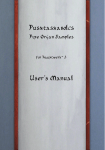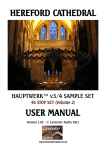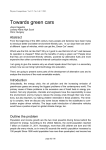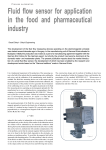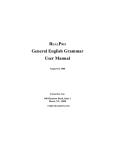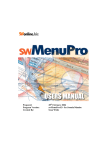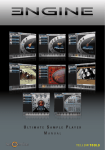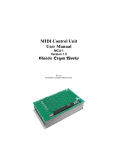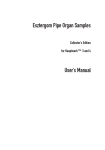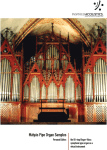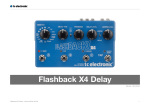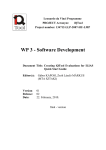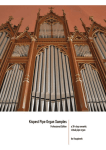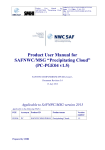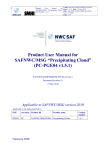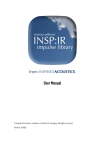Download Pusztaszabolcs Pipe Organ Samples User`s Manual
Transcript
Pusztaszabolcs
Pipe Organ Samples
for Hauptwerk™ 3
User’s Manual
SION
R
E
V
L
A
I
R
T
unlock at
ics.com
t
s
u
o
c
a
d
e
r
i
p
.ins
http://www
© Inspired Acoustics, a division of Entel Ltd, Hungary. All rights reserved.
Made in Hungary.
SION
R
E
V
L
A
I
R
T
unlock at
ics.com
t
s
u
o
c
a
d
e
r
i
p
.ins
http://www
Version 2009|B
SION
R
E
V
L
A
I
R
T
unlock at
ics.com
t
s
u
o
c
a
d
e
r
i
p
.ins
http://www
Table of contents
1 Welcome
1.1 Highlights
1.2 Hardware and software requirements
2 Installation
Controls of the virtual pipe organ
Pages
Modes
Keys and keyboards
Stops
Buttons
Combination Action
2.1
2.2
2.3
2.4
2.5
2.6
2.7
3 The Pazicky organ of Pusztaszabolcs
3.1 Short History
3.2 Disposition
4 5 The recording
Usage terms and conditions
5.1 End-user license agreement (EULA)
6 Credits
5 8 9 9 10 10 11 11 13 15 15 18 19 20 20 23 5
6
SION
R
E
V
L
A
I
R
T
unlock at
ics.com
t
s
u
o
c
a
d
e
r
i
p
.ins
http://www
1 Welcome
Welcome to the Pusztaszabolcs Pipe Organ Samples!
Pusztaszabolcs (PSZ) Pipe Organ Samples virtual pipe organ is a meticulously
sampled recreation of the 1778 Pazicky baroque organ of R. C. St. Imre
Pusztaszabolcs, Hungary.
1.1 Highlights
Feature highlights of this
organ:
•
Historical and Extended
editions selectable on-the-fly
•
Fully functional
Combination Action,
independent of Hauptwerk™’s combination action, controllable directly from
the screen or MIDI.
•
Optional tracker and engine noises
•
Touch sensitive tracker action noise and pipe transient response
•
and more
SION
R
E
V
L
A
I
R
T
unlock at
ics.com
t
s
u
o
c
a
d
e
r
i
p
.ins
http://www
1.2 Hardware and software requirements
Pusztaszabolcs Pipe Organ Samples is hosted within Hauptwerk™ virtual pipe
organ software, available for both PC and Mac computers from Milan Digital
Audio, found at http://www.hauptwerk.com on the Internet. Hauptwerk™
functions with both currently available 32-bit and 64-bit operating systems.
Hauptwerk™ Advanced Edition is recommended. A high-performance
computer is required to experience full, flawless and convenient operation of
this library.
1.2.1
RAM and number of loadable stops
Since Hauptwerk™ loads the sample data into the computer’s random access
memory (RAM) – and does not stream data from the hard disk – the amount
of RAM determines the number of stops you can load for playing at a given
time. The theoretical RAM limitation, per program instance is 4 GB in 32-bit
operating systems; loading all stops of the organ requires a 64-bit operating
system, capable of handling more than 4 GB of RAM. Regardless of operating
system, please make sure you are using more than 4 GB of RAM.
Hauptwerk™ allows you to load the library with a range of independent
options for each available stop, allowing you to trade off the number of
loadable stops with varying degrees of realism (you can, for example, choose
to load less than the full complement of release samples). Loading all of the
stops in their most complete multi-looped versions and with full release
samples will consume much more RAM than loading them with, say, single
looped data and/or truncated release tails.
Please refer to the Hauptwerk™ User’s Manual for a complete description of
how to maximize performance with these features.
Hauptwerk™ offers lossless compression for sample loading. We recommend
turning this option ON when loading the samples, since it does not affect the
quality of sound, but increases the number of stops one can load at a time.
The following table summarizes the loading requirements for the instrument.
SION
R
E
V
L
A
I
R
T
unlock at
ics.com
t
s
u
o
c
a
d
e
r
i
p
.ins
http://www
Loading setup
RAM requirement
24-bit, all loops, all attack layers, all
release samples, memory compression
10.2 GB
16-bit, all loops, all attack layers, all
release samples, memory compression
5.4 GB
16-bit, all loops, first attack layers, all
release samples, memory compression
3.6 GB
16-bit, first loops, all attack layers, all
release samples, memory compression
3.1 GB
16-bit, first loops, first attack layers, all
release samples, memory compression
2.4 GB
16-bit, first loops, first attack layers, 250
ms
simulated
dry,
memory
compression
1.0 GB
1.2.2 CPU and Polyphony
It is essential that your computer has a high-performance CPU in order to
experience full polyphony. A high polyphony capability is required when
many stops are drawn and many notes played together.
Note: Polyphony is defined as the number of stops being selected, times the number
of notes held per stop, including the duration release tails to sound, at any given time.
A series of fast staccato chords in Tutti will stress your computer the most,
because the initial release tails will continue to sound as additional staccato
chords are being played. For the most flawless operation, we recommend
the use of a 4-core CPU or better, equipped with the most RAM that you can
afford. As your CPU power increases, you can achieve more polyphony.
Please refer to the Hauptwerk™ User’s Manual for a complete description of
how to achieve maximum polyphony with your computer.
SION
R
E
V
L
A
I
R
T
unlock at
ics.com
t
s
u
o
c
a
d
e
r
i
p
.ins
http://www
2 Installation
Installing the Pusztaszabolcs Pipe Organ Samples requires that you own a
registered, installed copy of Hauptwerk™ virtual pipe organ software, together
with a registered, working USB key (dongle). Please do not attempt to install
the Pusztaszabolcs library unless you have a registered copy of Hauptwerk™
installed in your computer.
This installation procedure is for Hauptwerk™ version 3.21. If using a later
version of Hauptwerk™, the required steps may be slightly different in detail;
please refer to your version’s copy of the Hauptwerk™ User Guide.
1.
Download or insert the installation medium to your computer.
2.
Launch Hauptwerk™ virtual organ software in the “standalone” mode.
3.
From within Hauptwerk™, go to the file menu and select Install organ,
sample set, temperament or impulse response
a. The program will prompt you to select the program to install.
b. Navigate to the USB stick to select the first file set to install. All of
the available file sets should be installed in order to make the library
work.
c.
Click ‘Open’ and then click ‘OK’ on the next screen.
d. Wait until Hauptwerk™ finishes installing the file you have selected.
4.
Repeat Step 3 until all files have been installed from the installation
medium.
SION
R
E
V
L
A
I
R
T
unlock at
ics.com
t
s
u
o
c
a
d
e
r
i
p
.ins
http://www
2.1 Controls of the virtual pipe organ
The organ at the R.C. St. Imre of Pusztaszabolcs has one console, and has fully
mechanical action.
2.2 Pages
The organ controls are organized into so-called “Pages” in Hauptwerk™ to
allow convenient operation. Each page of this virtual instrument plays a
different role, and allows you to control and monitor the organ’s numerous
features in a convenient way. The following table summarizes the contents of
each page.
Page name
Description / Type
What is it for?
Console
Overview of the organ
console.
Check, control, observe and
demonstrate everything on one
screen, including drawbar stop,
keyboard and pedal movements.
Center
All drawbar knobs on one
page. Historical view.
For systems with a single touch display
screen, this page allows you to control
all stops from a single page.
Left
Left drawbar stops.
For systems with two individual touch
screens, you can place this screen to
the left of the keyboard, to control the
left bank of stops, just as on the real
instrument.
Right
Right drawbar stops.
For systems with two individual touch
screens, you can place this second
screen to the right of the keyboard, to
control the right bank of stops, just as
on the real instrument.
Ext
All drawbar knobs on one
page. Extended view.
This page is similar to the Center page,
but the stops are reorganized for more
convenience and the additional
buttons are permanently visible
allowing you to use these features in
the Historical Mode as well.
Advanced
Advanced controls
Advanced controls such as the Mode
selection, the Compass selection and
the Wind Stability control.
Note:
To respect the historical look of the organ console, additional console features,
left and right pages – such as the tracker, the engine or the combination
action buttons – are visible only when the Extended Mode is activated.
SION
R
E
V
L
A
I
R
T
unlock at
ics.com
t
s
u
o
c
a
d
e
r
i
p
.ins
http://www
2.3 Modes
The virtual version of the Pusztaszabolcs pipe organ has two operational
modes: the Historical Mode and the Extended Mode. You can select either
of these modes at any time using the ‘Advanced’ Page.
2.3.1
Historical Mode
The Historical Mode features the original controls and features of the
Pusztaszabolcs pipe organ.
2.3.2 Extended Mode
The Extended Mode extends the number of keys of the pipe organ (the
compass of the pipe organ) to 54 manual keys and 30 pedal keys to allow the
performance of an even wider range of baroque pieces.
Furthermore, the Extended Mode summons a virtual combination action onto
the organ console (and to the ‘Left’ and ‘Right’ pages).
2.4 Keys and keyboards
The virtual instrument boasts the Pusztaszabolcs’s two 45-note manuals and a
15-note set of pedals. All keys and keyboards are shown in a photo-realistic
perspective view, fully responsive to mouse control. The manuals and pedal
keyboard all faithfully mirror your performance.
2.4.1
Short octave
Some historical instruments, such as the Pusztaszabolcs organ are built with a
lower short octave. This means that some keys produce different sounds than
in other octaves. The following pictures show the two types of historical key
responses.
Historical Mode
historical key response
(original)
SION
R
E
V
L
A
I
R
T
unlock at
ics.com
t
s
u
o
c
a
d
e
r
i
p
.ins
http://www
Historical Mode
full key response
(MIDI-compatible)
The same short octave response applies to the pedal keys as well.
In the Extended Mode the keys are fully functional and responsive according
to the MIDI keys. This is achieved by electronically re-creating the notes that
were missing, based on the available notes.
2.5 Stops
The organ console features drawbar stops, which you
can click to activate. All drawbar knobs are animated
and their on/off status will be synchronized on all
pages.
Labels above each drawbar show the historical name of
the stop. Since the drawbars are animated in full
perspective, please make sure to touch or click on their
dark wooden part to make them move.
2.6 Buttons
Many features of this sample set can be controlled using buttons, as
described below.
2.6.1
Optional Noises | M,T
The Motor (M) and the Tracker Action (T)
noise buttons are buttons that will optionally
turn on the organ motor noise and the
velocity-responsive tracker action noise,
respectively. For those seeking ultimate realism,
just turn both of these on!
Note: Even if the T button is turned off, the pipes remain velocity responsive.
SION
R
E
V
L
A
I
R
T
unlock at
ics.com
t
s
u
o
c
a
d
e
r
i
p
.ins
http://www
2.6.2 All stops off button | 0
The Zero or general cancel button turns all stops and the
coupler off. In Pusztaszabolcs Pipe Organ Samples it is marked
with a zero (0) sign.
SION
R
E
V
L
A
I
R
T
unlock at
ics.com
t
s
u
o
c
a
d
e
r
i
p
.ins
http://www
2.7 Combination Action
The Combination Action of the Pusztaszabolcs Pipe Organ Samples is the
same unique combination action that was introduced first by the Palace of
Arts Budapest Pipe Organ Samples. You can control different sets of stops
(combinations) stored in the organ’s internal memory by a single click or
touch, uniquely right from the graphical interface.
This feature is independent of Hauptwerk’s™ own combination action system,
allowing more convenient use and the possibility to register the virtual
organ’s stop list in exactly the same way as on a real organ.
The key element of Pusztaszabolcs’s Combination action is the “Increment”
and “Decrement” button array, clearly marked with left- and right-facing
triangles.
Combination action is used to access presets of different stop configurations
with a single click, an essential feature when performing organ pieces in real
time.
2.7.1 Features
Pusztaszabolcs Pipe Organ Samples is capable of storing 8 combinations
within its internal memory. You can save and load these into a single file by
using Hauptwerk™’s built-in Save and Load functionality in the Combinations
menu (as of Hauptwerk™ Version 3.21).
The Combination Action, or “Setzer” in its Germanic name, is accessed and
controlled by a group of dedicated buttons. Eight numerical buttons
(numbered 1 - 8) can directly access the memory positions, and are also used
in conjunction with the arrow-like triangles buttons, permitting rapid
navigation within the combination memory.
2.7.2 Programming and resetting
Once you define a stop configuration on the console that you
wish to save as a combination preset (also called a “frame”),
press the S button once, and then press either a number or a
navigation key to select which combination frame you want
to program. If you select the same number that was previously active, the
previous combination will be overwritten with the new one.
SION
R
E
V
L
A
I
R
T
unlock at
ics.com
t
s
u
o
c
a
d
e
r
i
p
.ins
http://www
Hint: The easiest way to program a particular stop combination into the next frame is
to press the S set button and then press the increment button. This will program the
currently set configuration to the next frame and increment the current frame by one
to that frame – with a single click.
You can also assign MIDI messages to these buttons so that, if you have a
MIDI-capable console, all these functionalities can be directly available to you
in physical form as well.
Saving entire banks of combinations is just as easy as saving Hauptwerk’s™
own combinations, and can be configured using the same commands.
SION
R
E
V
L
A
I
R
T
unlock at
ics.com
t
s
u
o
c
a
d
e
r
i
p
.ins
http://www
3 The
Pazicky
Pusztaszabolcs
organ
of
3.1 Short History1
The history of the organ dates back to the turn of the 17th - 18th century, at
which time the organ resided in the 1717 Franciscan Saint Anna church at
Esztergom, in northern Hungary. The organ’s builder and the date of its
construction are still unknown, but according to recent research it was most
likely completed before year 1739. The first verifiable state of the organ, in the
Franciscan church, describes it as unpainted, with 9 stops on one single
manual (keyboard) and a pedal board, both operated in the back of the organ
case. There were no couplers. The wind supply was provided by two
wedge-blowers. Its tuning might have been one half-tone higher than
customary today, but was subsequently altered.
The first paintings appeared on the organ at the same time as the altar of the
church was painted. Unique in Hungary the paintings depict scenes of nature
on the removable back and side doors.
Since the organ was too small for the church, it was extended in 1778 by Jan
Pazický (spelled Pazsiczky at that times), who would go on to found an organ
building dynasty with a 120 year tradition. Pazicky extended the organ with a
second manual and a new positive work, added 2 more stops to the pedal and
a larger blower. This resulted in a 2+P, 17 (18) stop instrument.
After a few decades, the organ case was entirely painted to oil green. Later on,
in 1884, the organ was again re-painted – this time to brown, the pipe-work
for the two manual were physically separated and a new console was built in
between them. In 1892 a new blower was installed, and in 1918 the tin pipes
of the façade were collected to support the war. In 1925 these pipes were
rebuilt made of zinc. Meanwhile, the pipes of the short octave were cropped
to support chromactic scale on the lower octave, and the organ case was
painted white. In 1941 the Franciscans decided to build a new pipe organ,
resulting in the sale of the instrument to the city of Pusztaszabolcs through a
newspaper advertisement for the sum of 3000 pengő.
Background:
Pengő was the currency of Hungary between 1926 and 1946, following
the split of the Austro-Hungarian Empire after World War I when all
SION
R
E
V
L
A
I
R
T
unlock at
ics.com
t
s
u
o
c
a
d
e
r
i
p
.ins
http://www
1
based on http://www.barokkorgona.hu/index.php?id=7&L=2 and other sources
countries had to develop, design and manufacture their own new
currencies. According to the 1941 currency exchange rates, 3000
pengős was equal to approximately 216 British pounds, 4420 French
franks or 900 dollars.
Tarttinger János, organ maker of Érsekújvár completed the dismantling,
transportation, and construction of the newly acquired organ. Installation was
completed shortly before the Second World War. By the early fifties the
instrument was in a badly deteriorated state, so the church decided to fully
replace all internal parts, however, the appointed repairman had vanished
with the (prepaid) money collected for this purpose. Ironically this worked to
the organ’s advantage – saving it from ill-advised tampering, if only on a
temporary basis. It was not until the beginning of the nineties that the organ
was recognized again; several studies and plans were undertaken on how best
to restore the instrument. The pipe organ programme of the office of the
National Cultural Heritage, which in 2003 declared the organ as a Historical
Relic, finally allowed commencement of the restoration.
About 90 percent of the pipes, the mechanics and the 18th century status of
the organ case – although repainted several times – remained.
The main objective of the reconstruction was to restore the state of the 1778
Pazicky baroque instrument.
On 15 April 2002, the reconstruction of the organ was begun. The organ case
was reinforced and the pipes of the positive work were relocated further to the
rear. To achieve an acoustically better condition and to better replicate the
conditions of its original environment in Esztergom, the organ loft was
extended slightly during the reconstruction and the finally reconstructed
organ case was installed there. The paintings of the organ case remained in a
relatively good condition, needing only slight retouching after the removal of
the previously painted layers. The organ builder reconstructed the blowers, the
bellows, the mechanics and the keyboards according to documents of the
original state and examples of other Pazickzy organs in the region found
following extensive research by the restoration experts. Organs referenced
were the R.C. Church in Poroszka, (Pruské, in Slovakia) and an instrument
(maker unknown) in a Franciscan church in Bacs (Bac, in Slovakia).
The façade pipes of the positive work are the original Pazicky pipes, while the
zinc façade pipes of the great organ were replaced with appropriately
designed new ones made of 70% tin alloy. Some of them received decorative
embossing, according to the customs of Upper Hungary. The second row of
pipes (planned but never built by Pazicky) of the Mixtura stop was also added
during the reconstruction according to the original mensur (scale of pipes).
SION
R
E
V
L
A
I
R
T
unlock at
ics.com
t
s
u
o
c
a
d
e
r
i
p
.ins
http://www
From remaining parts the blower housing behind the organ and two new
edge-blowers with manually operable pedals were also restored, so the
instrument now can be operated with or without an organ engine. Based on
experiments the wind pressure was set at 65 mm. The tuning of the organ is
based at 448 Hz (25 ºC), in Werckmeister III.
The instrument is now in its original splendor, faithfully reconstructed to its
1778 Pazicky state. Today this instrument is the oldest and most completely
conserved pipe organ in Hungary.
The restoration was conducted by the Varga Orgonaépítő Kft supervised by
master organ builder László Varga. Advising experts were Bertalan Hock and
Péter Sirák; the organ case was reconstructed by Rezső Schwartz, and pictures
by Ildikó Jeszeniczky and Edit Perjés restoration artists.
SION
R
E
V
L
A
I
R
T
unlock at
ics.com
t
s
u
o
c
a
d
e
r
i
p
.ins
http://www
3.2 Disposition
II. Manual (great organ, 45 notes ~1700-1739)
Principal (8’)
Copula maior (8’)
Octav (4’)
Copula minor (4’)
Quinta (2 2/3’)
Sedecima (2’)
Quint minor (1 1/3’)
Mixtura (2x1’)
I. Manual (positive, 45 notes, 1778)
Coppel (8’)
Quintadena (8’)
Flauta minor (4’)
Principal (4’)
Octave (2’)
Super octave (1’)
Pedal (18 notes)
Petal (Subbass 16’ + Burdon 8’)
Octav bass (8’, ~1778)
Flauta bass (4’, ~1778)
Copula claviaturae (II+I, 1778)
SION
R
E
V
L
A
I
R
T
unlock at
ics.com
t
s
u
o
c
a
d
e
r
i
p
.ins
http://www
4 The recording
The recording was conducted in a continuous 24-hour recording session on
26-27 June, 2008. All samples were recorded at 192 kHz and acoustic
measurements were also conducted. Many photographs to support the
modeling of the virtual console were also made. During the recordings some
extremely noisy conditions were experienced due to a nearby air conditioning
unit (with a size of an entire room) which occasionally started to operate.
SION
R
E
V
L
A
I
R
T
unlock at
ics.com
t
s
u
o
c
a
d
e
r
i
p
.ins
http://www
5 Usage terms and conditions
5.1 End-user license agreement (EULA)
YOU SHOULD CAREFULLY READ ALL OF THE FOLLOWING TERMS AND
CONDITIONS BEFORE USING THIS PRODUCT. INSTALLING AND USING THE
PRODUCT INDICATES YOUR ACCEPTANCE OF THESE TERMS AND CONDITIONS.
IF YOU DO NOT AGREE WITH THEM, YOU SHOULD PROMPTLY RETURN THE
PRODUCT UNUSED AND YOUR MONEY WILL BE REFUNDED.
GRANT OF LICENSE. In consideration of payment of the license fee, Entel Ltd.
("Entel") grants to you, the Licensee, a nonexclusive, nontransferable license
to have one person use the enclosed Inspired Acoustics software product (the
"Product") on one personal computer at a time. If you want to use the
Product on more than one personal computer at a time you must obtain
separate licenses from Entel. All rights not expressly granted to Licensee are
reserved to Entel.
OWNERSHIP OF THE PRODUCT. Portions of the Product incorporate certain
material proprietary to third parties. Entel and licensors of Entel own and will
retain all title, copyright, trademark and other proprietary rights in and to the
Product. This License is not a sale of the Product or any copy of it. You, the
Licensee, obtain only such rights as are provided in this Agreement. You
understand and agree as follows: you may not make any copies of all or any
part of the Product except for archival copies of the computer software
components of the Product as permitted by law; you may not reverse
compile/assemble/engineer, modify, or incorporate in whole or in part in any
other product or create derivative works of similar purpose of the Product
based on all or any part of the Product; you may not remove any copyright,
trademark, proprietary rights, disclaimer or warning notice included on or
embedded in any part of the Product; you may not transfer or resell the
Product. This license expressly forbids resale, re-licensing or other distribution
of the Product. You cannot sell, loan, rent, lease, assign or transfer all or any of
the enclosed sounds in the Product to another user, or for use in any
competitive product(s). If transferred, in whole or in part, the original and
subsequent owners forfeit all rights to use the software; you may not use the
documentation for any purpose other than to support your use of the
Product; you may not perform engineering analyses of the Product, including
quality, performance or benchmark analyses, without the written permission
of Entel.
SION
R
E
V
L
A
I
R
T
unlock at
ics.com
t
s
u
o
c
a
d
e
r
i
p
.ins
http://www
USE OF AUDIO SAMPLES. The audio samples, recorded sounds, programs,
presets used by or included in the Product remain the property of Entel and
are licensed, not sold, to you for use on your computer. LICENSEE MAY USE
THE PRODUCT FOR COMMERCIAL PURPOSES WITHIN MUSICAL
COMPOSITIONS, AND MAY CREATE DERIVATIVE WORKS OF DIFFERENT
PURPOSE THAN THE PRODUCT SUCH AS SOUND RECORDINGS OR
PERFORMANCES OF MUSICAL COMPOSITIONS, BASED ON THE PRODUCT AND
MAY ALSO SELL THESE DERIVATIVE WORKS WITHOUT PAYING ANY FURTHER
ROYALTIES TO ENTEL. HOWEVER, LICENSEE IS STRICTLY FORBIDDEN TO: (1)
FALSELY REPRESENT THAT THE DERIVATIVE WORK, SUCH AS BUT NOT LIMITED
TO A SOUND RECORDING OR A MOVIE SOUNDTRACK, WAS PLAYED ON THE
ACTUAL INSTRUMENT THE PRODUCT IS VIRTUALIZED FROM OR ANY OTHER
REAL INSTRUMENT WHATSOEVER; (2) DOWNLOAD OR USE THE SAMPLES IN
DIFFERENT FORMAT OR WITH DIFFERENT SOFTWARE THE PRODUCT WAS
ORIGINALLY DESIGNED FOR. LICENSEE IS STRICTLY FORBIDDEN TO DISPLAY
OR USE FOR ANY PURPOSE OR IN CONNECTION WITH ANY OF LICENSEE’S
DERIVATIVE WORKS THE NAME(S) OR OTHER REPRESENTATIONS OF (1) THE
HALLS, INSTITUTIONS OR LOCATIONS OF THE INSTRUMENT(S) FROM WHERE
THE PRODUCTS ARE VIRTUALIZED FROM; (2) THE PLACE OF THESE
LOCATIONS; OR (3) THE MANUFACTURER(S) OF THE ORIGINAL INSTRUMENTS.
RESPONSIBILITIES. Entel hopes the Product will be useful to your business
or personal endeavors. However, Entel does not warrant the operation of the
Product or the accuracy or completeness of any information contained in the
Product. You, and not Entel, are responsible for all uses of the Product.
LIMITED WARRANTY. Entel warrants to you, the original licensee, that the
media on which the Product is recorded will be free of defects in material and
workmanship under normal use for a period of thirty (30) days from purchase,
and that the Product will perform substantially in accordance with the user
guide for a period of thirty (30) days from purchase. Entel’s sole responsibility
under this warranty will be, at its option, (1) to use reasonable efforts to correct
any defects that are reported to it within the foregoing warranty period or (2) to
refund the full purchase price to you. Entel does not warrant that the Product
will be error free, nor that all program errors will be corrected. In addition, Entel
makes no warranties if the failure of the Product results from accident, abuse or
misapplication. Remedies are available with a proof of purchase from an
authorized international source. All requests for warranty assistance shall be
directed to Entel at the following address: H-1301 Budapest, Pf. 94. Hungary.
+36/1/3360400. The expressed warranty set forth in this Agreement is the only
warranty given by Entel with respect to the entire Product. Entel makes no other
warranties, expressed, implied or arising by custom or trade usage, and
specifically disclaims the implied warranties of non-infringement,
merchantability or fitness for any particular purpose. Entel shall not be
responsible for the performance of the Product nor for any liability to any other
SION
R
E
V
L
A
I
R
T
unlock at
ics.com
t
s
u
o
c
a
d
e
r
i
p
.ins
http://www
party arising out of use of the Product. Entel’s liability in contract, tort or
otherwise arising in connection with the Product shall not exceed the purchase
price of the Product. In no event shall Entel be liable for special, incidental, tort
or consequential damages including any damages resulting from loss of use,
loss of data, loss of profits or loss of business arising out of or in connection with
the performance of the Product, even if Entel has been advised of the possibility
of such damages.
TERMINATION. This License Agreement will terminate immediately if you
breach any of its terms. Upon termination, you will be required promptly to
return to Entel or to destroy all copies of the Product covered by this License
Agreement.
GOVERNING LAW. The terms of this License shall be construed in
accordance with the substantive laws of Hungary (European Union).
NO WAIVER. The failure of either party to enforce any rights granted in this
Agreement or to take any action against the other party in the event of any
breach of this Agreement shall not be deemed a waiver by that party as to
subsequent enforcement of rights or subsequent actions in the event of
future breaches.
LITIGATION EXPENSES. If any action is brought by either party to this
Agreement against the other party regarding the subject matter hereof, the
prevailing party shall be entitled to recover, in addition to any other relief granted,
reasonable attorneys' fees and litigation expenses.
UNENFORCEABLE TERMS. Should any term of this License Agreement be
declared void or unenforceable by any court of competent jurisdiction, such
declaration shall have no effect on the remaining terms hereof.
YOU ACKNOWLEDGE THAT YOU HAVE READ THIS LICENSE AGREEMENT,
UNDERSTAND IT AND AGREE TO BE BOUND BY ITS TERMS AND CONDITIONS.
YOU FURTHER AGREE THAT IT IS THE COMPLETE AND EXCLUSIVE STATEMENT
OF THE LICENSE AGREEMENT BETWEEN YOU AND ENTEL WHICH SUPERSEDES
ANY PROPOSALS, OR PRIOR AGREEMENT, ORAL OR WRITTEN, AND ANY
OTHER COMMUNICATIONS BETWEEN YOU AND ENTEL RELATING TO THE
SUBJECT MATTER OF THIS LICENSE AGREEMENT.
SION
R
E
V
L
A
I
R
T
unlock at
ics.com
t
s
u
o
c
a
d
e
r
i
p
.ins
http://www
6 Credits
Created by
Csaba Huszty, Zsolt Albert, Tamás Kun, Reiner Suikat, Tamás Vadas, Péter
Balázs, Stephen Phillips, Joseph Felice.
Thank you
Father Nándor Baltási
This virtual pipe organ financially supports the original instrument.
SION
R
E
V
L
A
I
R
T
unlock at
ics.com
t
s
u
o
c
a
d
e
r
i
p
.ins
http://www























